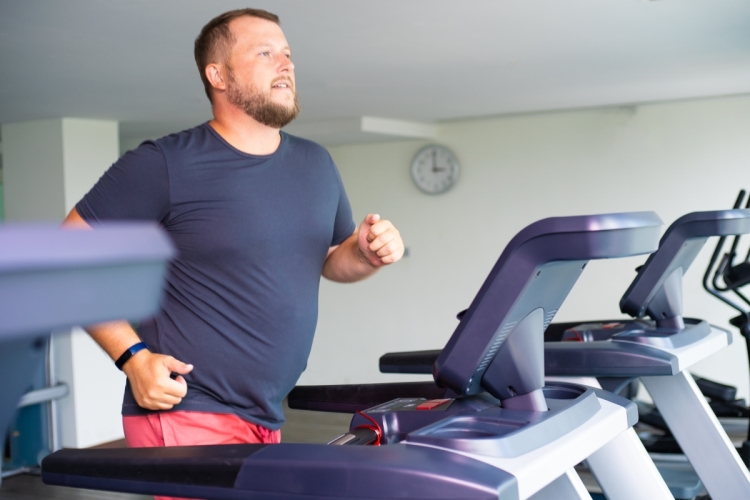Power Walking for Beginners – How to Walk for Better Health
Updated by Stephen Anton PhD on March 23rd, 2022

For years, walking has been a favorite choice in the world of exercise.
Whether you walk in a gym, on a treadmill, or out in nature around your neighborhood, it is a great source of exercise.
However, new research states that leisurely walking doesn’t have the heart-healthy results that power walking leads to (1).
What Is Power Walking?
Power walking means to walk at a vigorous pace.
The increase in your speed and endurance gives the results of a heart-healthy lifestyle.
Four Power Walking Benefits
Let’s stroll through some of the reasons that power walking is best!
Power walking is a great exercise, and like other endurance exercises, it can:
Power Walking Technique
Turning your normal walk into a fitness stride requires good posture and purposeful movements.
Ideally, here is how you should walk:
How to Start Power Walking
For some, walking for the recommended 30 minutes a day might be difficult. If so, try walking for 10-minute intervals and build up to three times a day. As your endurance improves, walk longer until you can advance to a single 30-minute walk.
A great target should be a minimum of 60 minutes a week, but as much as 150 minutes a week.
As your walk becomes easier, add new challenges, such as climbing a hill, extending the time you walk, increasing your walking pace, and an additional day of walking.
Keep Track of How Much You Are Walking
Step counters can help you keep track of your walking, set goals, and measure your progress.
Most inactive people get fewer than 5,000 steps a day, and some very inactive people get only 2,000 steps a day.
Try wearing a step counter for a few days to see how you’re doing. You will be surprised by your current step levels.
If you get:
Five Steps to Help Plan Your Power Walking Routine
As you start your walking routine, remember to:
Set Realistic Power Walking Goals
For most healthy adults, the new research guidelines recommend at least:
You can spread activity throughout the week. The guidelines also recommend strength training exercises of all the major muscle groups at least twice a week.
As a general goal, aim for at least 30 minutes of physical activity per day. If you can’t set aside that much time, try several 10-minute sessions throughout the day.
Remember, it’s OK to start slowly — especially if you haven’t been exercising regularly. You might start with five minutes a day the first week and then increase your time by five minutes each week until you reach at least 30 minutes.
Five Power Walking Activities to Stay Active
Walking is a simple way to stay active. You can do it alone, with friends, even with your dog!
Try one of the following activities to get active today:
Four Rules to Stay Motivated
Starting a walking program takes initiative. Sticking with it takes commitment.
To stay motivated:
Power Walk to Better Health
Keep in mind that according to this research, power walking (vigorous walking) is best to reduce cardiac risks.
You need to be doing this type of exercise at least several times a week for 30 minutes each, but the most valuable is 150 minutes a week.
By doing this exercise, you can expect to be feeling better, giving your body the workout it needs and reducing your risk for heart disease.
So, to walk or not? I say walk, and walk a lot!
Power Walking for Beginners – How to Walk for Better Health
Updated by Stephen Anton PhD on March 23rd, 2022

For years, walking has been a favorite choice in the world of exercise.
Whether you walk in a gym, on a treadmill, or out in nature around your neighborhood, it is a great source of exercise.
However, new research states that leisurely walking doesn’t have the heart-healthy results that power walking leads to (1).
What Is Power Walking?
Power walking means to walk at a vigorous pace.
The increase in your speed and endurance gives the results of a heart-healthy lifestyle.
Four Power Walking Benefits
Let’s stroll through some of the reasons that power walking is best!
Power walking is a great exercise, and like other endurance exercises, it can:
Power Walking Technique
Turning your normal walk into a fitness stride requires good posture and purposeful movements.
Ideally, here is how you should walk:
How to Start Power Walking
For some, walking for the recommended 30 minutes a day might be difficult. If so, try walking for 10-minute intervals and build up to three times a day. As your endurance improves, walk longer until you can advance to a single 30-minute walk.
A great target should be a minimum of 60 minutes a week, but as much as 150 minutes a week.
As your walk becomes easier, add new challenges, such as climbing a hill, extending the time you walk, increasing your walking pace, and an additional day of walking.
Keep Track of How Much You Are Walking
Step counters can help you keep track of your walking, set goals, and measure your progress.
Most inactive people get fewer than 5,000 steps a day, and some very inactive people get only 2,000 steps a day.
Try wearing a step counter for a few days to see how you’re doing. You will be surprised by your current step levels.
If you get:
Five Steps to Help Plan Your Power Walking Routine
As you start your walking routine, remember to:
Set Realistic Power Walking Goals
For most healthy adults, the new research guidelines recommend at least:
You can spread activity throughout the week. The guidelines also recommend strength training exercises of all the major muscle groups at least twice a week.
As a general goal, aim for at least 30 minutes of physical activity per day. If you can’t set aside that much time, try several 10-minute sessions throughout the day.
Remember, it’s OK to start slowly — especially if you haven’t been exercising regularly. You might start with five minutes a day the first week and then increase your time by five minutes each week until you reach at least 30 minutes.
Five Power Walking Activities to Stay Active
Walking is a simple way to stay active. You can do it alone, with friends, even with your dog!
Try one of the following activities to get active today:
Four Rules to Stay Motivated
Starting a walking program takes initiative. Sticking with it takes commitment.
To stay motivated:
Power Walk to Better Health
Keep in mind that according to this research, power walking (vigorous walking) is best to reduce cardiac risks.
You need to be doing this type of exercise at least several times a week for 30 minutes each, but the most valuable is 150 minutes a week.
By doing this exercise, you can expect to be feeling better, giving your body the workout it needs and reducing your risk for heart disease.
So, to walk or not? I say walk, and walk a lot!

Get the Beginner’s Guide to Intermittent Fasting
Take advantage of this FREE PDF and learn the basics of intermittent fasting.

Get the Beginner’s Guide to Intermittent Fasting
Take advantage of this 100% free PDF and learn the basics of intermittent fasting.

Get the Beginner’s Guide to Intermittent Fasting
Take advantage of this FREE PDF and learn the basics of intermittent fasting.









